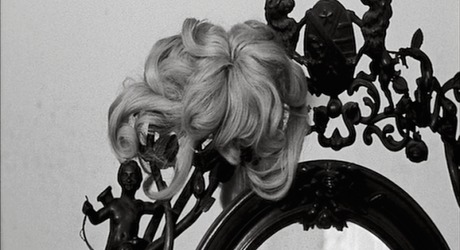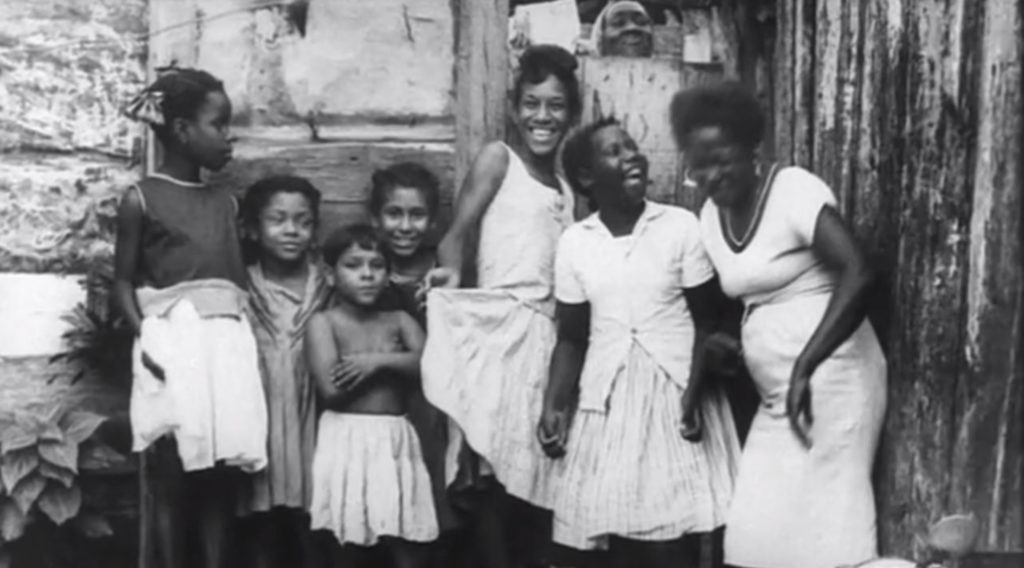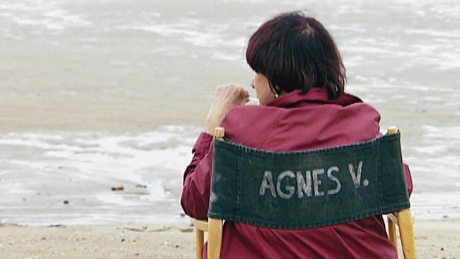
In Agnès Varda’s 1962 film Cléo de 5 à 7, cancer is mentioned enough that one begins perceiving it as a condition of existence rather than a sickness. Indeed, the film opens with an ominous diagnosis at a fortune teller: Cléo (Corinne Marchand) gets the death card in her tarot reading. The elderly seer soothes her with words about the cards having multiple meanings, but once Cléo leaves, the platitudes drop. “Elle est perdue,” the fortune teller remarks once Cléo is out of earshot: “She is lost.” This encounter broaches the social, and medical, fears around cancer, a reality that’s further complicated by the gendered experiences of cancer in the sixties—and to this day. In this, her second and best known film, Varda then tells the story of a woman who struggles with the finitude of her bodily modality as she is simultaneously derided and objectified. Confronting the gendered constraints placed on the cancer afflicted woman at the time, Varda boldly creates a narrative that resists the silencing of women’s experiences in favour of complex transformation and growth.
Cléo de 5 à 7 follows a young pop singer, for whom the film is named, over the course of two hours (Varda, in fact, toys with time, as the film’s run time is really 90 minutes), as she awaits the results of a biopsy. In this limbo, she struggles to make sense of a body that feels like it cannot be hers. Cléo’s feelings regarding her pending prognosis are taken lightly by everyone from her close assistant, to her musicians, and even to her lover: she is either dismissed as psychosomatic, or ridiculed for her “capriciousness.” The space within which to process feelings of fear are greatly circumscribed, an experience that was not uncommon to women in the early sixties.
Cancer was not only feared, but thought to hasten decay just by uttering its name. “At the time [of filming],” Varda herself has said, “the collective fear was of cancer, just as the nuclear bomb or war is now.” It was regarded as morally, if not literally, contagious. For women, cancer was an experience of pain that was invisible to others and had to be made that way. Susan Sontag observed the “lurid metaphor” which contoured women’s cancer experiences well into the seventies. She wrote of how it was considered to be de-sexualizing, afflicting those who are sexually repressed, inhibited and incapable of expressing anger. In a patriarchal culture that bases women’s self-worth on their aesthetic contributions, cancer impedes the capability to uphold a particular standard of physical normalcy. Sontag noted this meant a stronger push for either discreteness or prosthesis. The general message was that if you cannot provide the body we expect, please remain at the margins.
“At the time [of filming],” Varda herself has said, “the collective fear was of cancer, just as the nuclear bomb or war is now.”
Varda tackles the cancer taboo by illustrating the fraught connection between illness and gender. After Cléo’s ominous encounter with the fortune-teller, she leans on her beauty for comfort, as she sobs while regarding herself in a mirror. In voiceover we hear her inner monologue remind herself that “…ugliness is a kind of death. As long as I’m beautiful, I’m more alive than others.” The notion that illness diminishes beauty stems from the way cancer was perceived in the film’s sociocultural context. As Sontag notes, in the 20th century metaphors attached to cancer were that it is a disease that wrenched the body. Beauty is central to the way Cléo navigates her identity and sense of self. As a pop-singer often on public display, beauty is one of the primary ways Cléo navigates and interacts with the world and those around her.
Varda plays with the idea that a woman’s primary purpose is to be an ornamental object to be gazed at. Without stripping Cléo of her agency as a handsome woman who enjoys her beauty, she presents a dilemma in which it is unclear who is in charge. By factoring in a pending prognosis that could potentially strip a woman of her primary function in a patriarchal society (to be a desirable object), we begin to wonder, what is left of her? This crisis of self-representation sets the tone for the struggle suffered in silence by cancer-afflicted women in the sixties, wherein Cléo attempts to locate a self in which she is fully in charge.
Engaging with Cléo’s existential dilemma, Varda demonstrates how much of her identity is dependent on external definitions. These definitions are dictated by the characters around her, on whom she relies for guidance and validation. Angèle (Dominique Davray), her assistant, infantilizes her, dismissing her experiences. Her lover, José (José Luis de Vilallonga), regards Cléo as a hypochondriac. Her two musicians, played by Serge Korber, and the film’s composer Michel Legrand, make a comic spectacle out of Cléo’s anxieties. Varda uses these characters as reminders of the ways in which women’s illnesses are often not taken seriously, misdiagnosed or dismissed as psychosomatic. The theme of illness in the film becomes a terrain on which to contest the function, desirability and validity of a woman’s selfhood in a patriarchal society that constrains how she presents herself and processes her emotions.

Returning to the theme of beauty, Cléo manipulates that which makes her desirable in order to dislodge herself from that which feels imposed. After a confrontation with her musicians during a rehearsal in her home, she changes out of her silky (and somewhat silly) robe and removes her wig, dressing instead in a plain black dress with a simple necklace and shawl. Here, for the first time, she takes to the streets alone and subverts the public’s gaze by controlling her image. In this way, Cléo resists objectification and assumes agency by stripping herself of her to-be-looked-at-ness, seeking her own space away from those that deny her the reality of her experience.
Cléo resists objectification and assumes agency by stripping herself of her to-be-looked-at-ness, seeking her own space away from those that deny her the reality of her experience.
A physical transformation often accompanies a woman’s experience with cancer. As Audre Lorde writes from her own experience with cancer, women’s spiritual transformations are undermined and de-emphasized in order to prioritize the aesthetically preferred; prosthesis, wigs and plastic surgery. This, she argues, is a denial for woman’s opportunity to heal herself, to re-envision herself. While a woman’s choosing prosthesis or wigs in no way undermines her agency or autonomy, a refusal to choose either is sanctioned, as Lorde writes. Varda facilitates Cléo’s journey to struggle and resist in order to seek healing and re-envisionment.
In the final part of the film, Cléo is walking through Parc Montsouris where she meets Antoine (Antoine Bourseiller), a French soldier on leave from Algeria. Antoine confesses his feelings about the Algerian War (which was coming to its bloody end during the filming) and French soldiers dying every day: for Antoine, death has become an offensively meaningless event. Where Cléo’s fears were previously derided, with Antoine, they are given the weight and attention they warrant. Importantly, too, Antoine offers to join Cléo as she heads to meet her doctor to get the results of her biopsy: he doesn’t just validate her by listening, but offers his presence as support.

The hours between five and seven are used to demonstrate the struggle and suffering experienced by a potentially cancer afflicted woman against the background of societal taboo and patriarchal oppression. With the introduction of Antoine, Varda does not diminish Cléo’s experience in contrast to his. Instead, she emphasizes the space attained by Cléo; one in which she is in control of her self-representation, of how she views herself and of how others view her. Right before her diagnosis is confirmed (during a painfully causal, if not anti-climatic, chance encounter with her male doctor as he breezily heads out for the day), Cléo has already made peace with her body’s impermanence. She has come to the realization that the body is all too woefully just a body, but she comes to this realization on her own terms, in the context of being finally listened to, rather than being subdued. Finally, she is fully in control.





